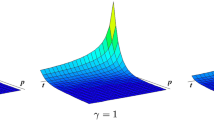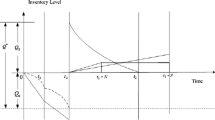Abstract
This paper investigates the problem of ordering and pricing over a finite time planning horizon for an inventory system with advance sales and spot sales. It is assumed that the planning horizon is divided into several sales cycles each of which is divided into an advance sales period and a spot sales period. During the advance sales period, all customers are required to make reservations for their orders and will receive them at the arrival time of the replenishment orders. In the case of the spot sales periods, all customers receive their orders at the time of the purchase. In actual practice, since customers with reservations may cancel their orders before receiving them, this paper considers this phenomenon and develops a continuous time inventory model to deal with the proposed problem. This paper maximizes the total profit over a finite time planning horizon by determining the optimal advance sales price, spot sales price, order size, and replenishment frequency. Analysis of results shows that a simple algorithm can be developed to arrive at an optimal decision.
Similar content being viewed by others
References
Abad PL (1996). Optimal pricing and lot-sizing under conditions of perishability, and partial backordering. Manage Sci 42(8):1093–1104
Abad PL (2001). Optimal price and order size for a reseller under partial backordering. Comput Oper Res 28:53–65
Abad PL (2003). Optimal pricing and lot-sizing under conditions of perishability, finite production and partial backordering and lost sale. Eur J Oper Res 144:677–685
Argon NT, Güllü R, Erkip N (2001). Analysis of an inventory system under backorder correlated deterministic demand and geometric supply process. Int J Product Econ 71:247–254
Baker RC, Urban TL (1988). A deterministic inventory system with an inventory-level-dependent demand rate. J Oper Res Soc 39(9):823–831
Barbosa LC, Friedman M (1978). Deterministic inventory lot size models – a general root law. Manage Sci 24(8):819–826
Bolander SF, Gooding CW, Mister WG (1999). Transfer pricing strategies and lot sizing decisions. J Manage Issues 11(2):155–165
Boyaci T, Gallego G (2001). Minimizing holding and ordering costs subject to a bound on backorders is as easy as solving a single backorder cost model. Oper Res Lett 29:187–192
Burnetas AN, Simth CE (2000). Adaptive ordering and pricing for perishable products. Oper Res 48(3):436–443
Chang HJ, Dye CY (1999). An EOQ model for deteriorating items with time varying demand and partial backlogging. J Oper Res Soc 50:1176–1182
Chen X (2003). Coordinating inventory control and pricing strategies with random demand and fixed ordering cost. Manuf Ser Oper Manage 5(1):59–62
Chu CW, Patuwo BE, Mehrez A, Rabinowitz G (2001). A dynamic two-segment partial backorder control of (r,Q) inventory system. Comput Oper Res 28:935–953
Chun YH (2003). Optimal pricing and ordering policies for perishable commodities. Eur J Oper Res 144:68–82
Dye CY, Ouyang LY (2005). An EOQ model for perishable items under stock-dependent selling rate and time–dependent partial back logging. Eur J Oper Res 163:776–783
Gallego G, Ryzin GV (1994). Optimal dynamic pricing of inventories with stochastic demand over finite horizons. Manage Sci 40:999–1020
Hariga MA (1995). Effects of inflation and time-value of money on an inventory model with time-dependent demand rate and shortages. Eur J Oper Res 81:512–520
Hsu VN, Lowe TJ (2001). Dynamic economic lot size models with period-pair-dependent backorder and inventory costs. Oper Res 49(2):316–321
Kunreuther H, Richard JF (1971). Optimal pricing and inventory decisions for non-seasonal items. Econometrica 39(1):173–175
Kunreuther H, Schrage L (1973). Joint pricing and inventory decisions for constant priced items. Manage Sci 19(7):732–738
Lau AHL, Lau HS (2002). A comparison of different methods for estimating the average inventory level in a (Q;R) system with backorders. Int J Product Econ 79:303–316
Luo W (1998). An integrated inventory system for perishable goods with backordering, Comput Indus Eng 34(3):685–693
McCardle K, Rajaram K, Tang (CS2004). Advance booking discount programs under retail competition. Manage Sci 50(5):701–708
McGill JI, Ryzin GJV (1999). Revenue Management: Research Overview and Prospects. Transp Sci 33:233–256
Moe WW, Fader PS (2002). Using advance purchase orders to forecast new product sales. Manage Sci 21(3):347–364
Petruzzi NC, Dada M (1999). Pricing and the newsvendor problem: A review with extension. Oper Res 47:183–194
Resh M, Friedman M, Barbosa LC (1976). On a general solution of the deterministic lot size problem with time-proportional demand Oper Res 24(4):718–725
Shugan SM, Xie J (2000). Advance pricing of services and other implications of separating purchase and consumption. J Ser Res 2:227–239
Tang CS, Rajaram K, Alptekinoglu A, Ou J (2004). The Benefits of advance booking discount programs: model and analysis. Manage Sci 50(4):465–478
Teng JT, Yang HL, Ouyang LY (2003). On an EOQ model for deteriorating items with time-varying demand and partial backlogging. J Oper Res Soc 54:432–436
Teng JT, Chang CT (2005). Economic production quantity models for deteriorating items with price- and stock-dependent demand. Comput Oper Res 32:297–308
Weatherford LR, Bodily SE (1992). A taxonomy and research overview of perishable-asset revenue management: yield management, overbooking, and pricing. Oper Res 40(5):831–844
Weatherford LR, Pfeifer P (1994). The economic value of using advance booking of orders. Omega Int J Manage Sci 22:105–111
Whitin TM (1955). Inventory control and price theory. Manage Sci 2:61–80
Xie J, Shugan SM (2001). Electronic tickets, smart cards, and online prepayments when and how to advance sell. Manage Sci 20(3):219–243
Yang HL, Teng JT, Chern MS (2002). A forward recursive algorithm for inventory lot-size models with power-form demand and shortages. Eur J Oper Res 137:394–400
You PS (1999). Dynamic pricing in airline seat management for flights with multiple flight legs. Transp Sci 33:192–206
You PS (2003). Dynamic Pricing of inventory with cancellation demand. J Oper Res Soc 54:1093–1101
Author information
Authors and Affiliations
Corresponding author
Rights and permissions
About this article
Cite this article
You, PS., Wu, MT. Optimal ordering and pricing policy for an inventory system with order cancellations. OR Spectrum 29, 661–679 (2007). https://doi.org/10.1007/s00291-006-0067-y
Published:
Issue Date:
DOI: https://doi.org/10.1007/s00291-006-0067-y




